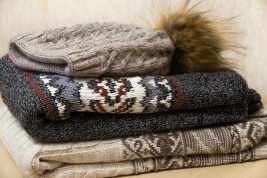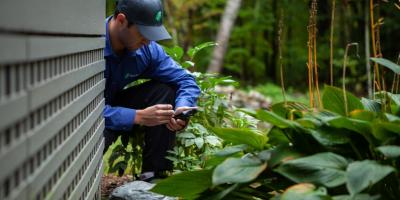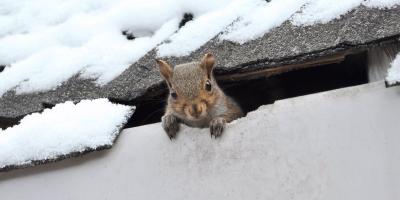Keep Your Favorite Winter Sweaters Safe From Clothes-Eating Insects

Many people are aware that moths have a propensity to eat clothing made of wool. The whole reason your mother placed mothballs in your closet when you were younger was to protect your cozy-but-laughably-ugly holiday sweaters from hungry insects, and not simply to make your room smell like stale chemicals. But plenty of people don’t realize that moths aren’t the only insects feeding on your fabric. Below, we’ve listed a few of the most common threats to your sweats, as well as numerous methods to keep your clothes intact.
Webbing Clothes Moth (Tineola Bisselliella)
Originating from Europe and Asia, the Webbing Clothes Moth has made its way to all 50 states in the U.S., but prefers climates with a relatively high average humidity. This species is especially drawn to wool and silk that contains traces of human sweat, human oils, hair, tomato, beer, or milk. The nutrients in these substances help their larvae develop into healthy adults. The fully grown adult moths have a wingspan of approximately half an inch, and tend to appear in greater numbers during warmer months, but can easily reside in a warm indoor environment year round. They prefer to live in dark attics and closets.
Most species of fabric-eating insects will feast on materials and natural fibers that contain the protein keratin, which can be found in hair, fingernails, skin, feathers, and animal hooves.
Black Carpet Beetle (Attagenus unicolor)
Adult carpet beetles do not feed on fabric, but their larvae do. The larvae will begin feeding once they hatch, and are particularly attracted to natural fibers such as wool, hair, and feathers. Usually, the larvae are discovered on furniture or clothing, but can crawl to any part of your home: into dark corners, behind baseboards, and into air ducts. A typical female carpet beetle can lay about 100 eggs that will hatch in eight to fifteen days, or even faster in warmer weather.
Although other species of carpet beetle exist, such as the Furniture Carpet Beetle (Anthrenus flavipes) and the Common Carpet Beetle, (Anthrenus scrophulariae) the Black Carpet Beetle is the most common and most destructive. The different species of carpet beetles can be distinguished by their coloration and markings.
Silverfish
Aside from destroying your clothing, silverfish can also have an incredible appetite for your books, photos, and tapestries. This nocturnal insect will leave its habitat at night to eat as much as it can before returning to a suitable hiding spot (your closet, for example). Because silverfish prefer to eat carbohydrates and anything that contains starch, they tend to destroy any linens or fabrics that have been treated with starch.
Silverfish can be found where humidity levels are relatively high, and they thrive in cool, dark, moist locations such as attics, basements, closets, baseboards, and bathrooms. Sometimes, they will even enjoy bundling up in warm, soft textiles.
Protecting Your Fabrics
- Proper storage is essential. Always wash your garments before putting them away for the season, and store them in plastic bins with tight-fitting lids. You may even want to wrap your storage bins in nylon, since the material is indigestible to silverfish.
- Lavender and cedar emit a smell that is noxious to silverfish. Try placing these scents in areas where you store your fabrics.
- Vacuum regularly and thoroughly. Make sure your vacuum has good suction to ensure you eliminate any eggs nesting deep within your carpets or baseboards.
- If you notice a particular piece of clothing is infested, wash and dry the item on the hottest setting available. Dry cleaning will also destroy moth and beetle larvae.
- Mothballs can be stored with natural fiber materials to prevent infestation and also to kill populations of clothes moths. Mothballs are poisonous, and should be handled carefully.
- Keep the humidity low. Clothes moths enjoy a relative humidity of approximately 75 percent, so use a dehumidifier to make the surrounding environment undesirable for them.
Are insects feasting on your fabrics? The experienced professionals at JP Pest Services can get rid of clothes-eating insects from your home quickly and completely! Contact JP Pest Services to request a free residential estimate today!



